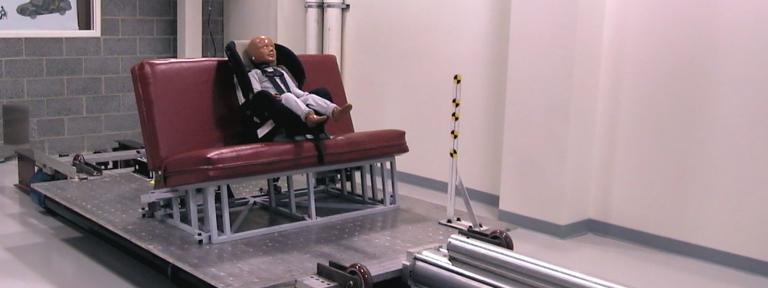
Sometimes unrestrained is a good thing - like when it applies to enthusiasm, creativity or children on a playground. But not when it applies to wearing seatbelts or using child safety restraints in a car.
To illustrate that point, Dr. Janet Brelin-Fornari, associate professor of Mechanical Engineering and director of the Kettering University Crash Safety Center, conducted an unrestrained crash test Tuesday, Feb. 28, for her Dynamics class.
The test involved putting a crash dummy representing a 12-month-old infant on the lap of a fifth percentile female crash dummy in the driver's seat during a 28 mph crash event, with neither wearing safety restraints, and a live air bag in the steering column.
The air bag was a key factor in this crash test. "Airbags and children don't mix," said Brelin-Fornari, referring to what researchers call the "air bag slap," the force of the deploying air bag that can cause serious or fatal injuries to infants and small children.
The dummies had their faces and knees painted with chalk to identify where they came into contact with the interior of the vehicle and/or the deploying air bag during the crash event.
In addition to chalk evidence, digital instrumentation in the dummies enabled data acquisition of myriad forces impacting them. Researchers will use the data to calculate potential injuries in this type of crash event. Of particular interest to the Kettering researchers was the acceleration (relating force of the head hitting interior parts of the car) of the infant's head to determine risk of injury.
In the aftermath of the crash event, with the adult dummy half hanging out of the occupant compartment and the infant-sized dummy hanging by his computer tether outside the vehicle, students, faculty and medical doctors on hand were all stunned.
"This relates to what you see on the streets," said Max Oppelt, an exchange student at Kettering from Munich, Germany. Oppelt is an ambulance driver in Germany, studying to be an automotive engineer. He said he had never seen a bad accident as an EMT, but that colleagues had, and said it was life-changing.
Dr. Patrick Atkinson, associate professor of Mechanical Engineering and director of Orthopaedic Research at McLaren Regional Medical Center, was present for the crash event and was one of the first to view the data coming from the dummies. He said the initial data showed the infant dummy's head "experienced approximately 30 Gs of deceleration for a long time. The chance of a serious brain injury in this situation is very high," he said.
G forces are the forces of acceleration that pull on an object when the object (or person) changes their plane of motion. The force of gravity on Earth is used as a baseline for measuring these forces of acceleration. For comparison, the force of gravity when you sit, stand or lie down is considered 1 G. If a person experienced the force of 9 Gs, the acceleration would cause their 10-pound head to weigh the equivalent of 90 pounds. The infant in the crash test experienced 30 Gs.
"It's important for parents to put a child in the appropriate restraint," said Brelin-Fornari, "and adults should always ride with a restraint, especially with an air bag present," she added.
One of the assignments for Brelin-Fornari's Dynamics (the study of things in motion) class will be to calculate the forces on the child from the unrestrained adult. "For example," she said, "during a 30-mph crash event, a 150-pound woman with a child on her lap in the driver's seat could potentially pin the child to the steering wheel with 4,000 pounds of force." This force is a result of the vehicle decelerating as the unrestrained occupant continues to move forward. Eventually the vehicle stops and the occupant makes contact with the vehicle interior.
The test was repeated on March 1 with the dummies unrestrained on the passenger side of the salvage vehicle with an air bag. Data from both tests will be analyzed and archived for future reference, and increase understanding of the dynamics of crash events to help develop safety features in vehicles.
The testing was made possible by two technicians, two co-op students and three generous donors. Clint Lee, senior lab coordinator in Mechanical Engineering, John Young, crash safety consultant, and co-op students Michael Holiday, of Flint, and Chad Ortiz, of Swartz Creek, helped secure the components needed for the testing and assembled the crash sled with the salvage vehicle.
Kayser Threde donated use of computer instrumentation to deploy an airbag for the test and Denton ATD Inc., donated the two dummies and calibration of the dummies, for use the day of the test. The passenger compartment of the salvage vehicle used was donated by Mike's Auto Salvage in Flint, Mich.
Denton ATD, Inc., produces a full line of regulated and non-regulated crash dummies and dummy laboratory calibration equipment for the automotive safety and aerospace industries.
Kayser-Threde GmbH, founded in 1967, is a leading systems house specializing in developing and implementing data management solutions for technical and scientific environments.
Written by Dawn Hibbard
810-762-9865
dhibbard@kettering.edu